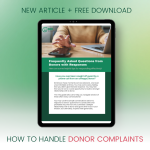6 Donor Retention Strategies for Your Nonprofit
Recently, I had the privilege of attending the NIO Summit hosted by NextAfter, a gathering of nonprofit professionals dedicated to improving digital fundraising efforts. One common thread that emerged from the discussions was the importance of donor retention.
This got me thinking about what happens after new and reactivated donors take the first step to support a cause. By implementing some simple donor retention best practices, nonprofits can create a meaningful and engaging experience for new and reactivated donors, ultimately fostering long-lasting partnerships.
Donor retention in the nonprofit sector is tough! M&W’s Benchmarks for 2022 paints a surprising picture. It revealed that only 16% of donors who made their first online gift in 2021 decided to extend their support into the following year.
This statistic underscores the urgency for nonprofits to focus on donor retention strategies that create a memorable and engaging experience, especially for those supporters who come on board during the busy fall and holiday season. Now, let’s dive deeper into how these donor retention strategies can lead to long-lasting partnerships with your donors.
1. The Power of Gratitude
Gratitude is the bedrock of donor relationships. When donors choose to support your cause, express your appreciation with genuine sincerity. A prompt and heartfelt thank you message after their donation sets the tone for a positive donor experience, and is a feature of any solid donor retention strategy. If you’re a BDI client partner, The BDI Library is at your disposal for more resources like customizable thank you letters and more!
2. The Impact of a Welcome Email and Mailing
Send a warm and informative welcome via email and mail. This communication should provide an overview of your organization’s mission, explain how their contribution will make a difference and highlight upcoming ways that they can get involved.
3. Inviting New Donors to Become Monthly Givers
Monthly donors provide a consistent and stable source of support. Invite new donors to consider becoming monthly givers. Explain the benefits of sustained giving and offer an easy way for them to set up recurring donations. Monthly donors not only provide steady income but also tend to be more engaged with your organization.
4. Sharing Impactful Stories
Storytelling is a powerful tool for engaging donors. Share impactful stories about the individuals or communities your organization serves. Showcase the real-world results of previous donations, highlighting the tangible changes they’ve helped create. Utilize platforms like Viewspark to create and send videos to donors to make these stories even more compelling.
5. Engaging with a Donor Survey
A donor survey is a valuable tool for understanding new donors better. Ask about their motivations for supporting your cause, communication preferences and expectations. Use this feedback to tailor your donor engagement strategies to their individual needs and affinity.
6. The Significance of Thank You Calls
Personal connections can significantly enhance the donor experience. Consider making thank you calls to your new and reactivated donors. These calls provide an opportunity to express gratitude verbally, answer any questions they may have and collect valuable feedback. A brief, friendly conversation can leave a lasting positive impression and deepen their commitment.
Nurturing new and reactivated donors is vital for donor retention and the long-term success of your nonprofit. By implementing these donor retention best practices, you can create meaningful connections, engage donors emotionally and build lasting partnerships that will benefit your organization for the future.
Looking for more ways to keep the love alive with your new donors? BDI is here to help! Send me an email and I’d be happy to share more about how we can come alongside your nonprofit with strategies to retain your new donors and cultivate their long-term support.
Check out last week’s Quick Shot – “Your Organization Needs Monthly Giving Programs. Here’s why…”>>





